本文由 Felixx 授权mooool发表,欢迎转发,禁止以mooool编辑版本转载。
Thanks Felixx for authorizing the publication of the project on mooool, Text description provided by Felixx.
Felixx: 荷兰政府顾问委员会和费利克斯景观设计事务所调查了步行在当代城市环境中的潜在作用。调查得知,步行是一种很有潜力的出行方式。它可能不是最快的,也可能不是最舒适的,但它是唯一一种不需要交通工具的出行方式。选择步行这种低碳方式出行,能减少我们对环境造成的影响。并且,步行空间能释放部分城市空间,从而能增强城市在应对社会和环境问题的抗压性。但奇怪的是,在日常公共空间设计中,步行空间常常被忽视。上述内容是在与城市心理学家Sander van der Ham–STIPO密切合作下得出的结论。其中明确了步行有哪些潜在的好处,并确定了如何实现这些好处的设计任务。
Felixx: The Dutch Board of Government Advisors and Felixx Landscape Architects & Planners investigated the potential role of walking in contemporary urban environments.Walking has great potential. It may not be the fastest, and as some may say not the most comfortable way to get around, but it is the only type of movement which doesn’t require a vehicle. By walking more, we limit the influence of our movements on the environment. As a result, creating room for walking frees up space in the city, which can be used to tackle diverse social and environmental challenges. Oddly enough, the pedestrian is often forgotten in the design of our public spaces. This research by design is developed in close collaboration with urban psychologist Sander van der Ham – STIPO. It provides insight into the potential benefits of walking, and identifies the design tasks within our built environment to realize these benefits.
▼步行潜在的功能:增加城市的抗压性the potential of walking:tackling diverse social and environmental challenges
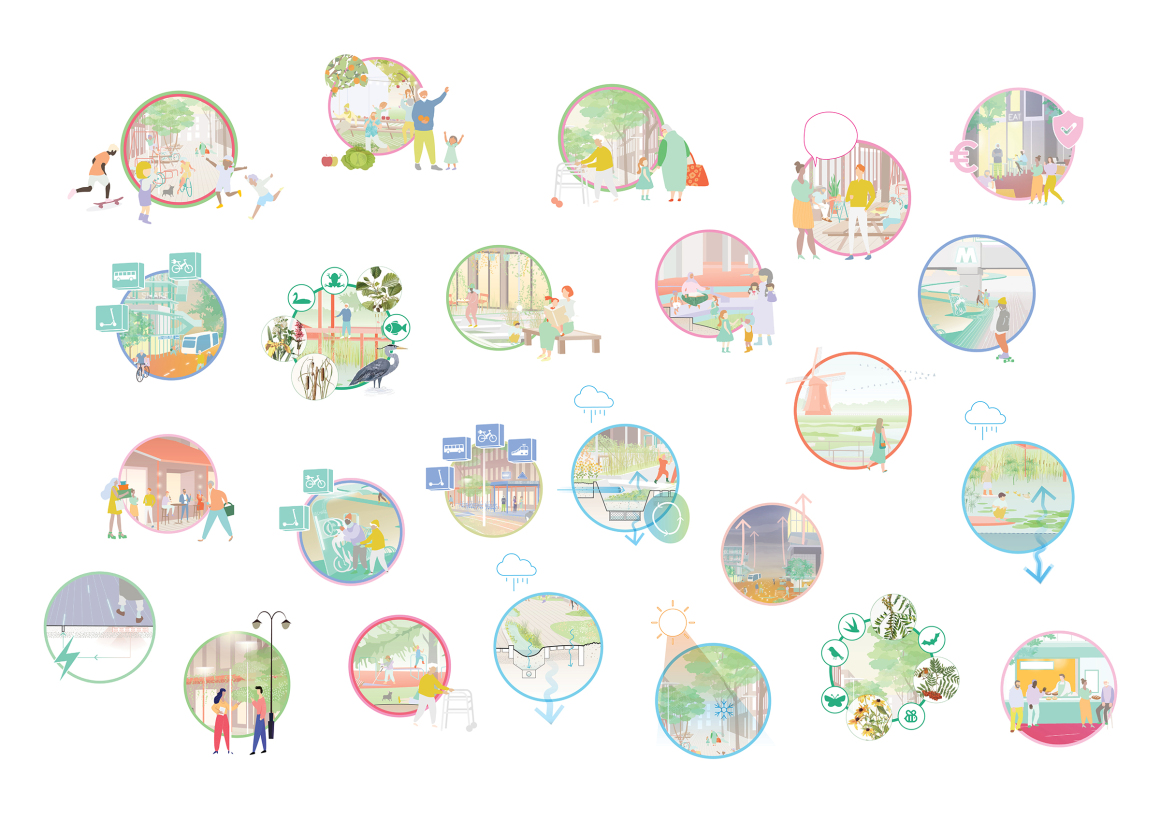
步行可作为出行的一种选择Walking as a choice
在生活中,步行是多种出行选择中的一种,但是我们通常不会特意去选择步行作为出行方式。为了设计出鼓励人们多走路的环境,我们需要了解如何才能引导人们选择步行。研究得出,这会受许多因素的影响。其中最主要因素是我们的大脑,我们的大脑会存储、处理我们在生活中所经历的一切。大体来说,我们的大脑有2套不同的系统来影响我们做出选择。
面对不同的情况,大脑会启用不同的系统,在系统1的情况下,我们会做出无意识的、情绪化的决定。这种选择是基于经验来判断的,在这种情况下,我们不会进行思考就会做出选择。而在系统2的情况下,我们处于理性的状态,会进行有意识的思考。这时我们会对之前的经验做批判性的思考,从而做出明智的选择。为了促进大家选择步行出行,我们需要在设计城市步行空间时同时考虑这两个系统。
Walking is a choice, although we often do not make that choice very consciously. In order to create environments that encourage people to walk more, we need to understand how we can influence people’s choice to do so. The choice of walking is influenced by many factors. Everything we experience in the course of our lives is stored in our brain as information. We roughly have two methods or “systems” to interpret this information, and make choices based on it.
System 1 makes unconscious, emotional, fast, automatic, and effortless decisions. Choices are based on rules of thumb that originate from previously acquired knowledge, experiences or emotions. They undergo little to no critical reflection. System 2 is rational and requires conscious reflection and costs a lot of energy. It allows informed choices to be made, and questions the rules of thumb of system 1. To boost walking, we need to address both systems in our way of designing cities.
▼心理决策影响城市环境Psychological decisions affect the urban environment
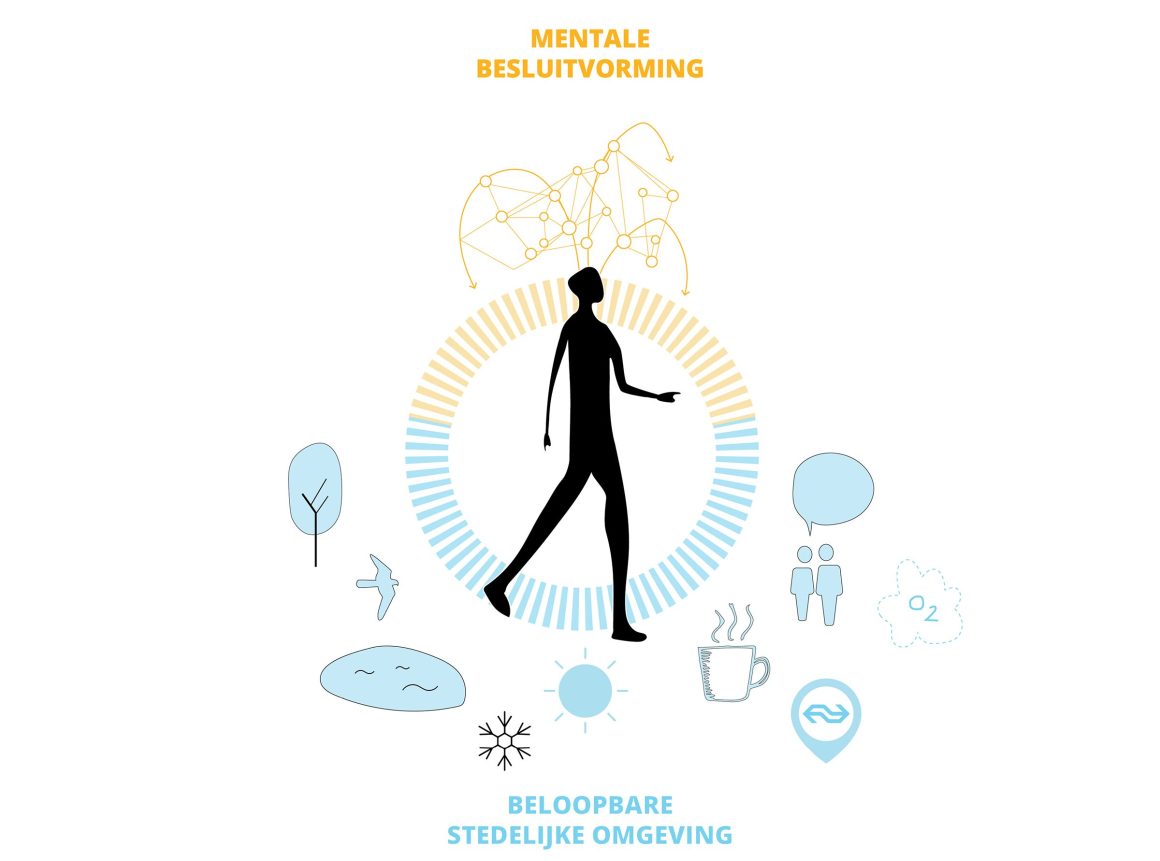
出行方式The Journey approach
生活中的步行空间通常是基于城市道路设计来安排的。这就导致我们在去向某地时,关注的是如何花费更少的时间到达目的地,而忽略了途中美丽的风景。这也证实了我们大脑系统1的偏见:当你要出行时,它会默默告诉你,如果你选择开车或骑自行车出行时就能更快达到目的地。如今以道路设计来安排步行空间的方式已潜移默化的深入我们生活中,现在我们想要做出改变,将社会与步行重新联系起来,首先需要将以人为本的设计应用到我们的街道和公共空间。基于舒适度好、可达性好和回报性高的原则做出的人性化步道空间,在潜意识中引导我们选择步行。
Space for walking is often designed according to the same “mechanical” logic as that of roadways. The experience en route is secondary to reaching the destination as quickly as possible. This constantly confirms the prejudices of system 1 in our brain: you are faster by car or by bicycle. Reconnecting society with walking, after years of applying generic rules of car environments, starts by applying human-oriented measures to our streets and public space. Walkable spaces based on enhancement of comfort, proximity, and rewarding can bring humanized street designs that subconsciously tempt us to choose to walk.
▼将社会与步行重新联系起来,做出舒适度好、可达性好和回报性高的步道空间Connecting the society and walking again, and making a comfortable, accessible and rewarding footpath space

将步行作为完成各项目标的催化剂Walking as a catalyst for different agenda’s
从长远目标来看,步行能使我们做出更明智、有意识的决定。通过批判性地反思我们当前的经验和习惯,随着时间的推移,步行会成为一个更优势的选择。我们可以将步行与城市环境建设联系起来,帮助实现社会目标。这使得选择步行不仅仅是选择一种出行方式,更是一种减少空气污染,建设更清洁、更健康世界的自觉选择。通过将步行与不同的目标联系起来,能够鼓励我们选择步行,也拔高了步行它本身的意义。链接越多样化,就越能让大众感到有必要走得更远。
By placing walking in a broader context, we can make better informed conscious decisions. By critically reflecting on our current rules of thumb and habits, walking can become a more obvious choice over time.We can achieve this by linking the act of walking to the contribution it makes to social and environmental agendas. This makes the choice for walking more than a mere choice of mobility. It becomes a conscious choice for less air pollution and a cleaner and healthier world.By associating walking with different challenges and objectives, we create arguments that can encourage us to walk and transcend the practical consideration of going somewhere by foot. The more diverse the links, the wider the audience that will feel compelled to walk.
▼步行是一种减少空气污染,建设更清洁、更健康世界的自觉选择Walking becomes a conscious choice for less air pollution and a cleaner and healthier world.
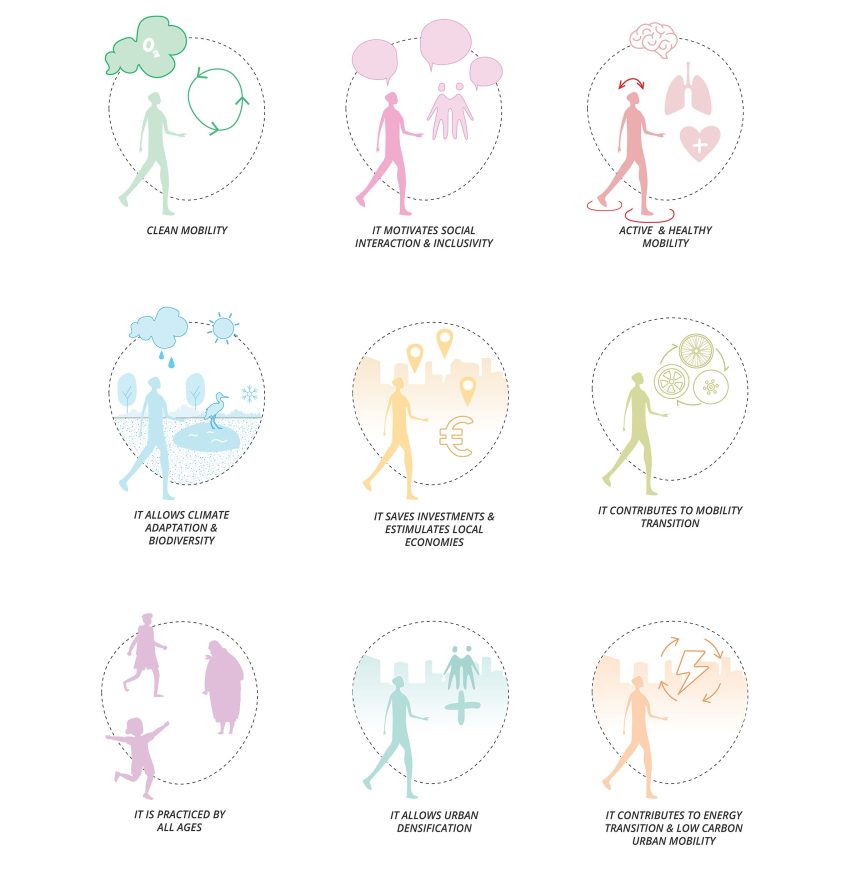
适宜步行的城市The walkable city
毫无疑问,20世纪是汽车化的时代。汽车的大规模生产使交通运输业发生了革命性的转变,是交通民主化的一个里程碑。我们对出行效率和出行便捷的追求,使我们在设计城市空间布局时首要考虑的依据是城市道路。即,城市空间被设计为尽可能快速高效地从A地到B地的空间逻辑。
The 20th century was without a doubt the century of the automobile. Mass production of cars had revolutionized mobility and represented a milestone in the democratization of transport. The pursuit of speed and individual freedom has led to a spatial layout which follows the logic of the car. This legacy is still visible in our urban environment today. Cities are still largely organized to get from A to B as quickly and efficiently as possible.
▼将从A到B的简单逻辑转换为体验式的景观方式Transforming the simple logic from a to B into an experiential landscape

本研究提出一种将基础设施转化为功能性体验景观的方法。打造一个适宜步行的城市与建设便捷化的道路一样重要,将街道、河道和景观、社区服务设施,学校、城市广场和公共交通站这类结构,作为旅途中的一部分,而不是在已有基础设施的基础上再分配步行空间。
The research proposes a method to transform an infrastructure network into a functional experiential landscape. A walkable city where the journey is as important as the destination, recognizes local streets, green-blue networks, neighborhood services and amenities, schools, urban plazas, and public transport stations as the structural elements for a walking operational journey, rather than limiting the walking realm to sidewalks parallel to car infrastructure.
▼将街道、河道和景观、社区服务设施,学校、城市广场和公共交通站这类结构,作为旅途中的一部分。Incorporating such structures as streets, waterways and landscapes, community services, schools, city squares and public transportation stations as part of the journey.
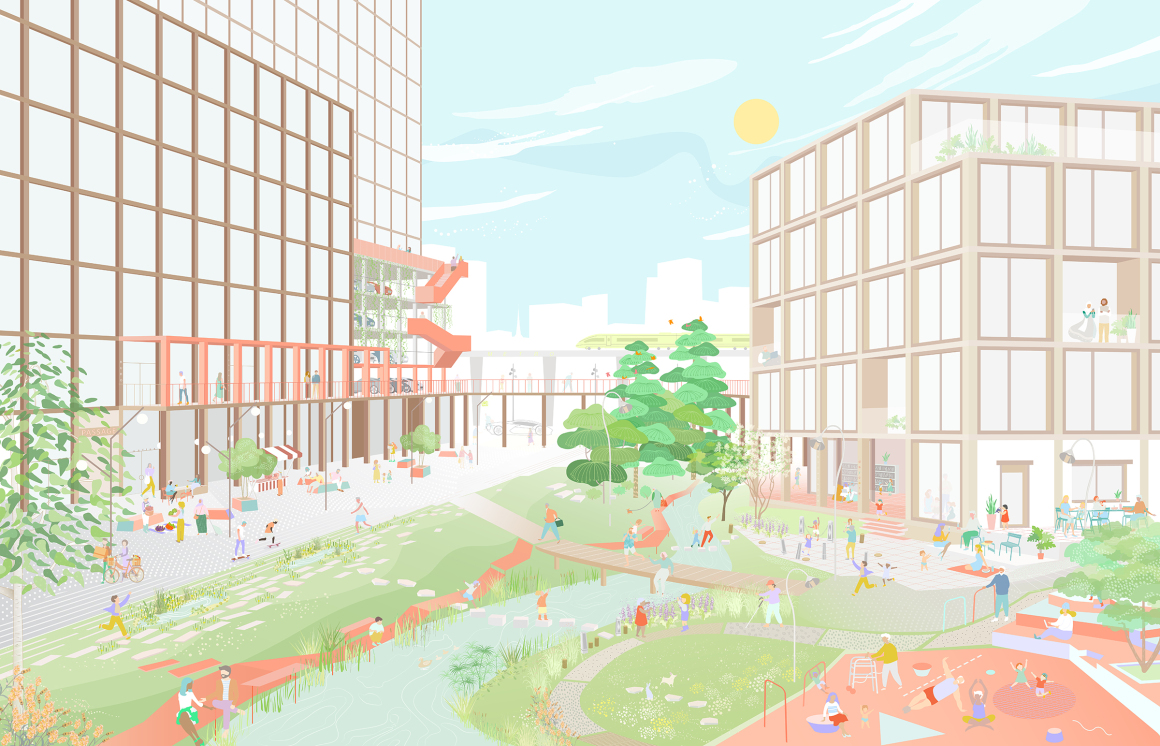
在这瞬息万变的时代,步行可作为实现各种目标的催化剂。例如,在增加步行空间后,可将调节气候、节能减排、建设城市安全、控制人口增长的策略联系起来。
In a timeframe of changing mobility, walking can act as a catalyst to realize various governmental agendas. Strategies for, for example, climate adaptation, emission reduction, safety, densification and population growth can be linked in the space that is freed up by the increase of walking.
▼在增加步行空间后,可将调节气候、节能减排、建设城市安全、控制人口增长等策略联系起来。After the increase of walking space, the strategies of climate regulation, energy conservation and emission reduction, urban safety construction and population growth control can be linked.
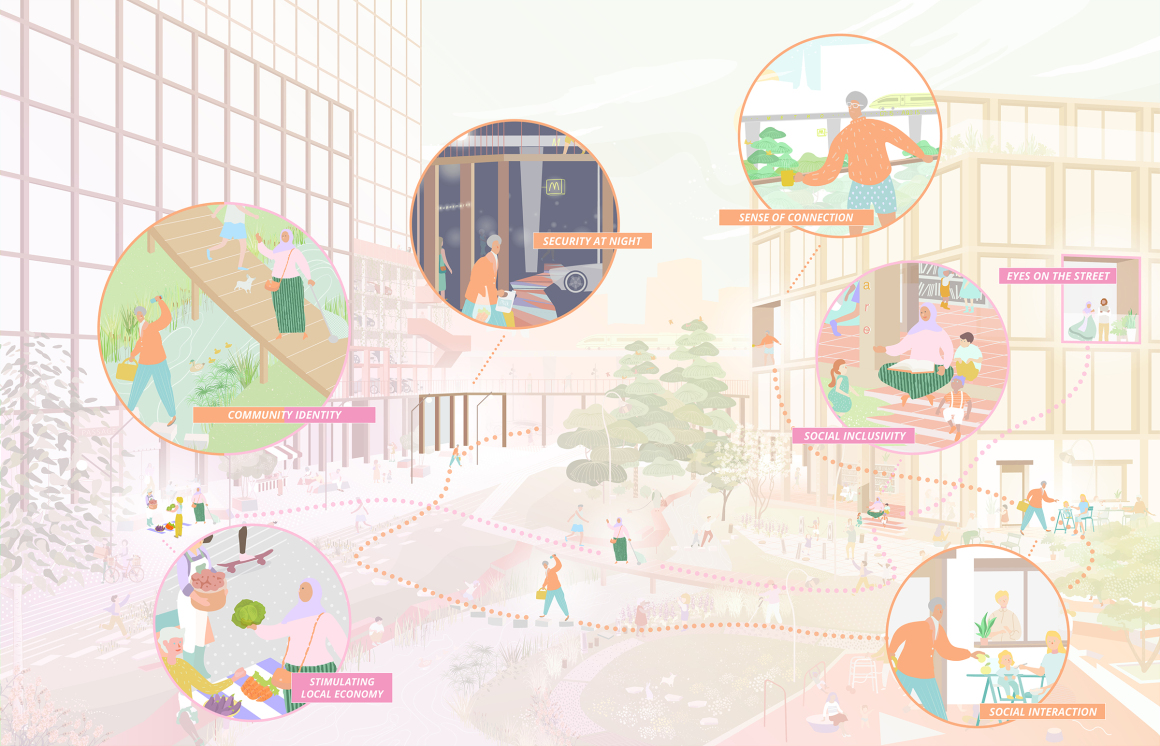
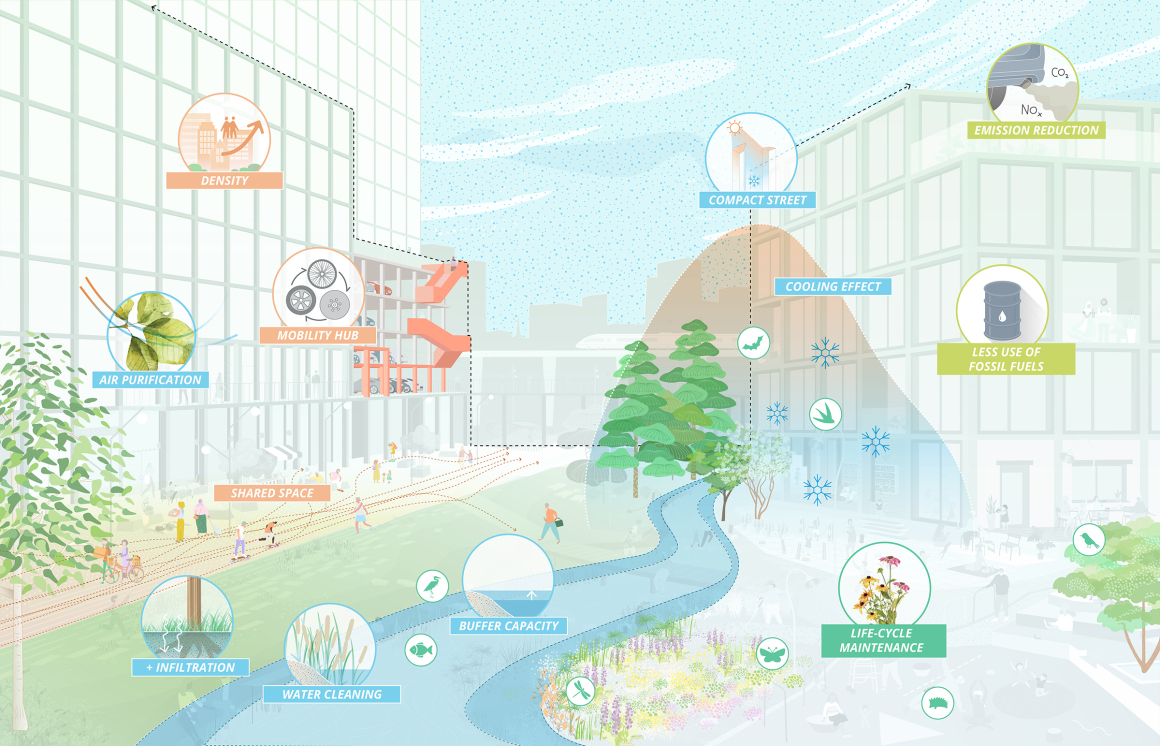
但这种联系是有一个前提条件的,即城市生活中,必须要有吸引大众选择步行的空间。这需要规范空间尺度,使活动形式具有吸引力,互动空间更灵活。适宜步行的城市所提出的理念,即为健康可持续的城市理念。
But this link also comes with a requirement in return. The experience of the city must entice residents and visitors to walk. In this city human scale is normative, physical activity is stimulated and space for social interaction is created. A walkable city shares a design brief with that of a sustainable and healthy city.
▼步行能够给人带来健康的体魄,从而达到健康城市的理念Walking can bring people a healthy body, so as to achieve the concept of a healthy city.
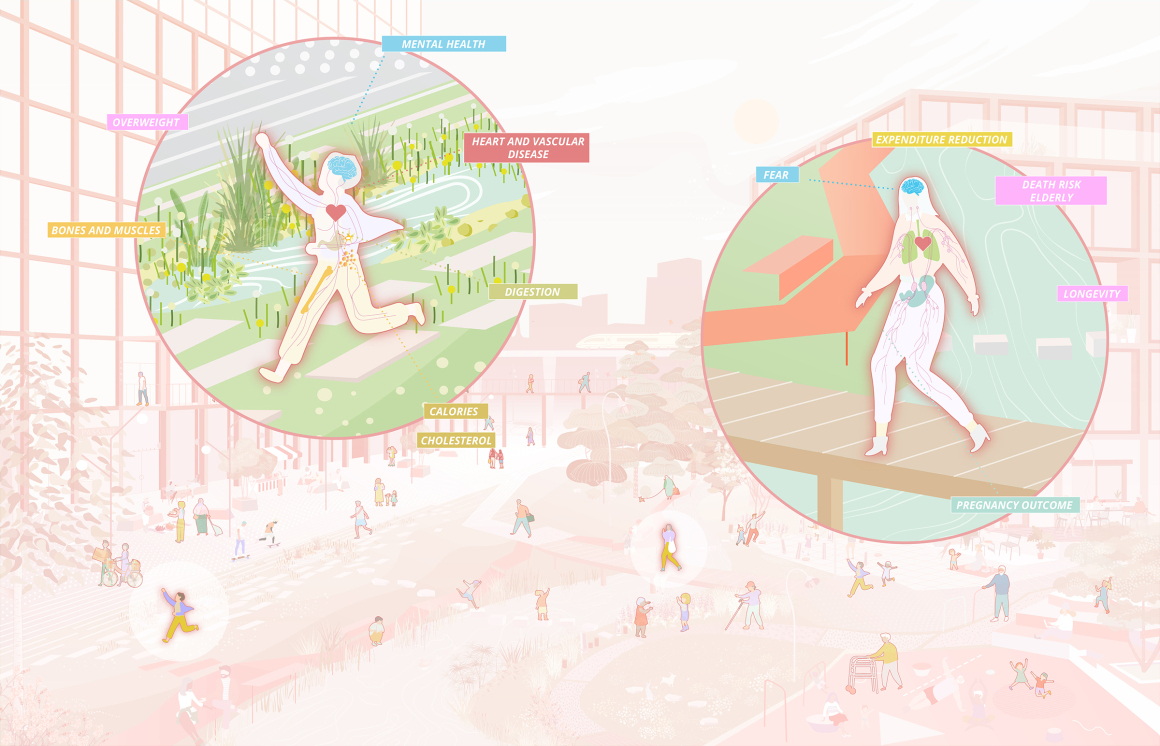
实践案例:荷兰城市鹿特丹Rotterdam as a test case
为了研究步行城市的可行性,本研究以鹿特丹为例进行了实践。城市是一个有趣的研究对象,因为汽车在城市设计中发挥了主导作用。在市中心遭到轰炸后,政府制定了《鹿特丹重建基本方案》,这为建立一个全新的街道模式创造了机会。
To investigate the feasibility of the walkable city, the research takes Rotterdam as a testcase. The city is an interesting study area because of the dominant role the car has played in the design of the city. After the bombing of the city center, the “Basic Plan for the Reconstruction of Rotterdam” was developed. The devastated area was swept clean, creating the opportunity to build a completely new street pattern according to modernist principles.
▼案例位置 case site
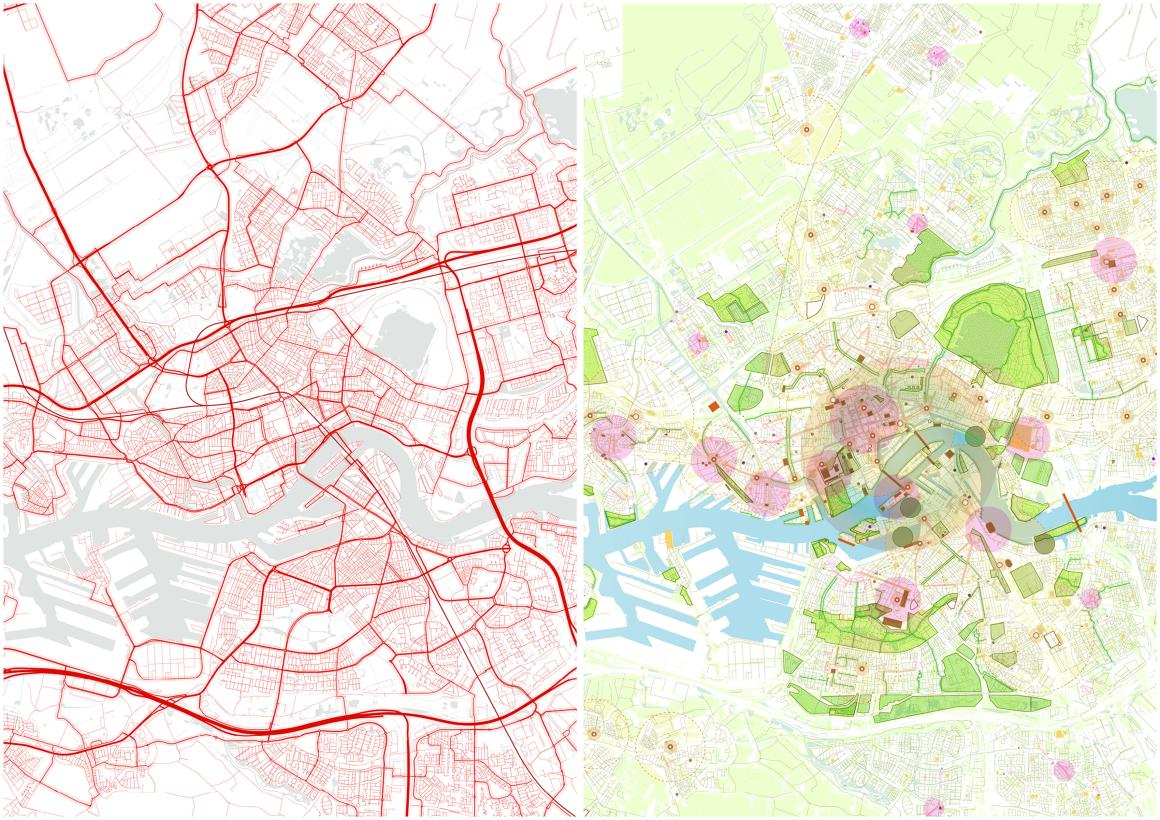
我们尝试将生活区和工作区分开,打造一种“未来的交通”方式。我们选择了四个实践点,来尝试将汽车影响下的城市布局转变为适宜步行的城市布局。
Living and working areas were separated, and space was created for the “traffic of the future”. Four test locations were selected, to test the transformation from a car-oriented layout, to a walkable city.
▼实践点1,城市更新区-Nieuwe Westen Case 1 Urban renewal districts – Nieuwe Westen



▼实践点2,战后的社区- Ommoord Case 2 Post-war neighborhoods – Ommoord
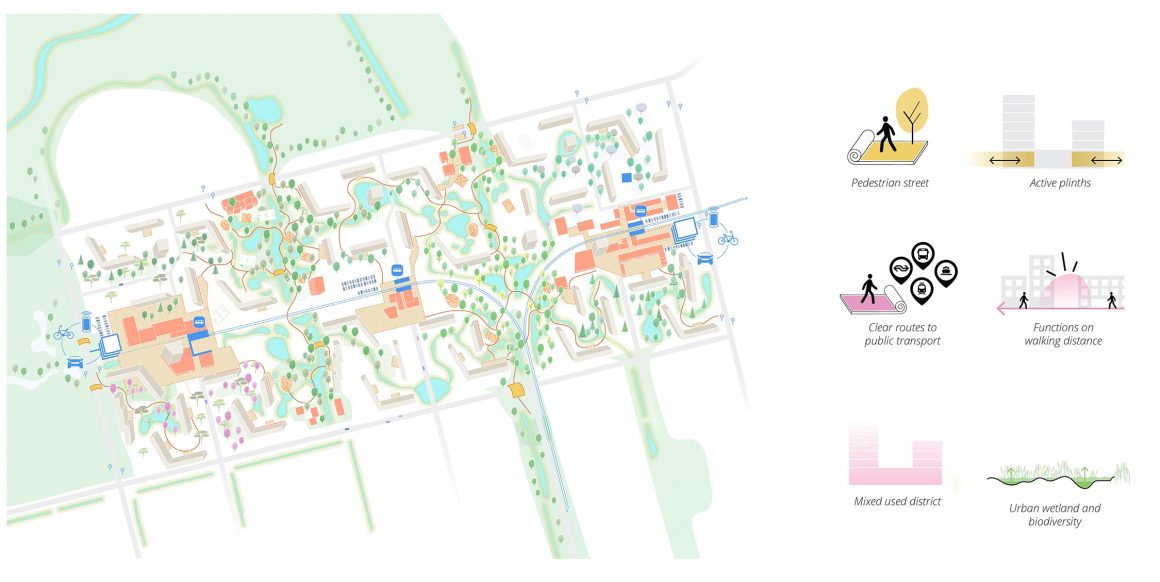
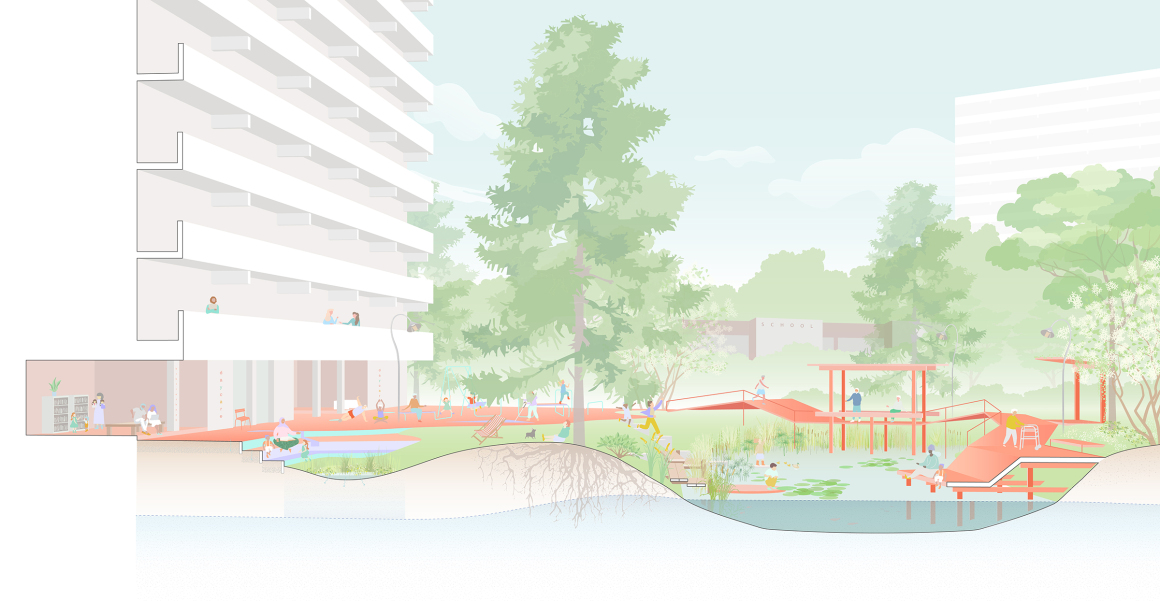
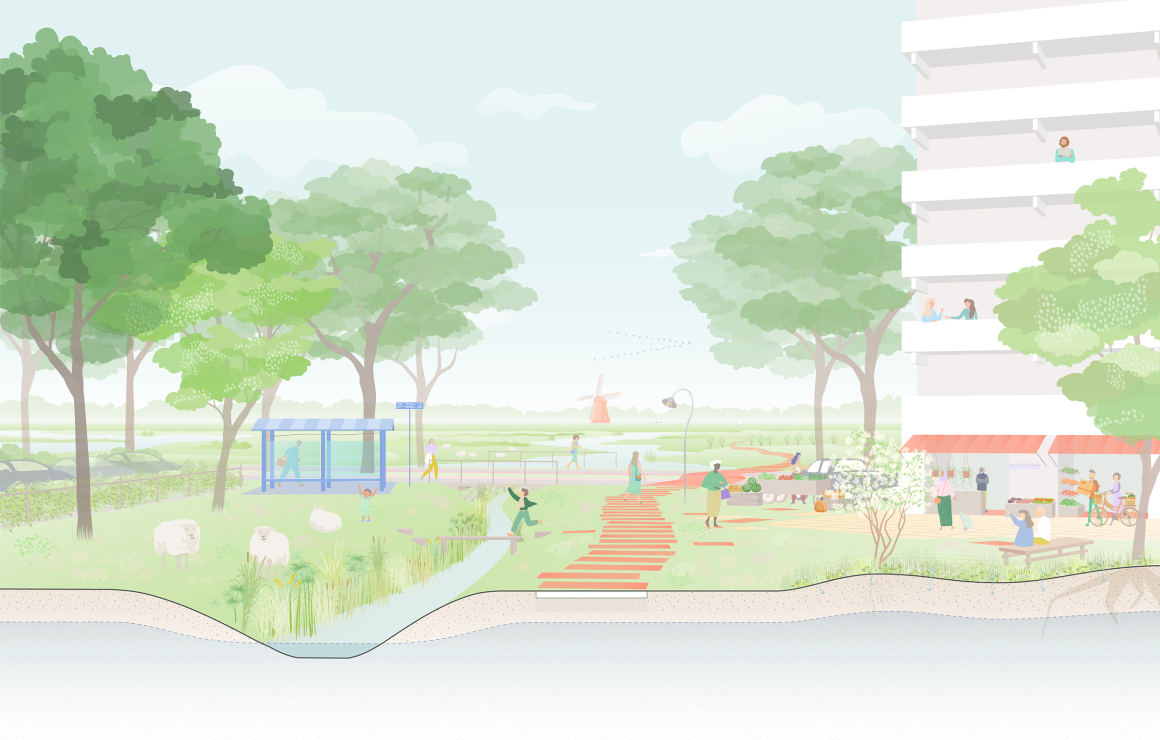
▼实践点3,住宅区- Hoogvliet Case 3 Residential district – Hoogvliet
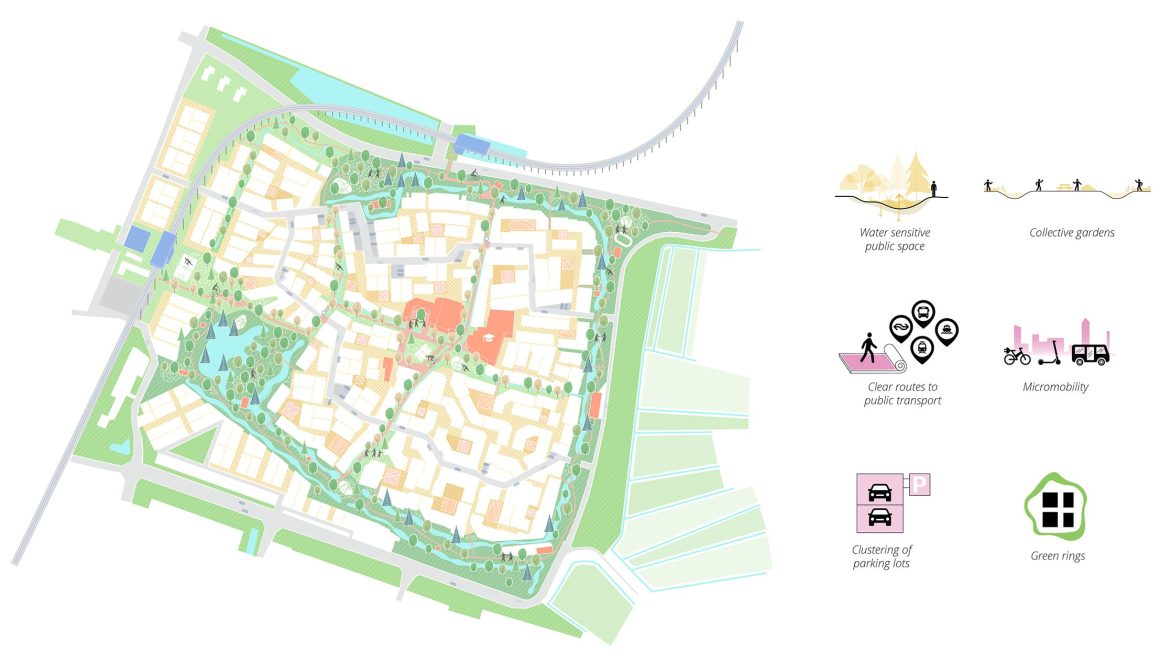
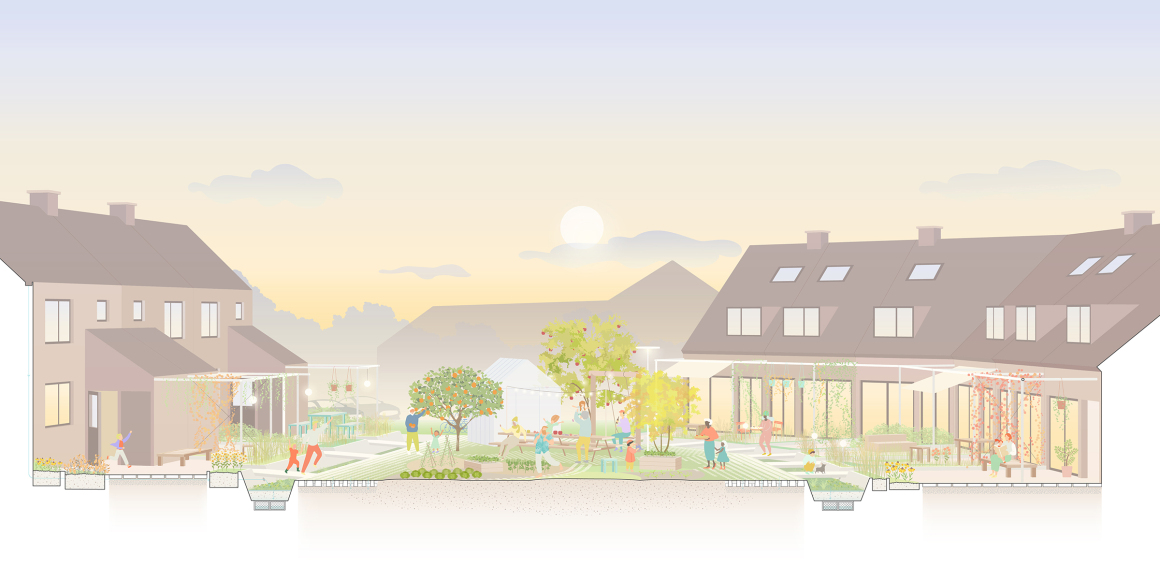
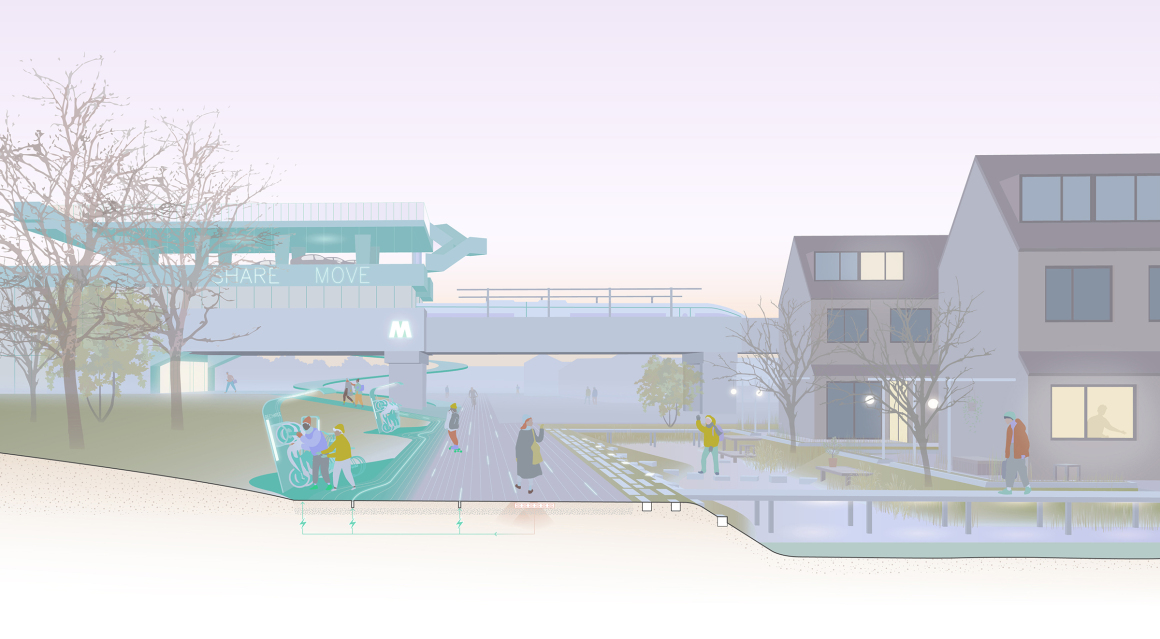
▼实践点4,商务公园- Spaanse polder Case 4 Business park – Spaanse polder

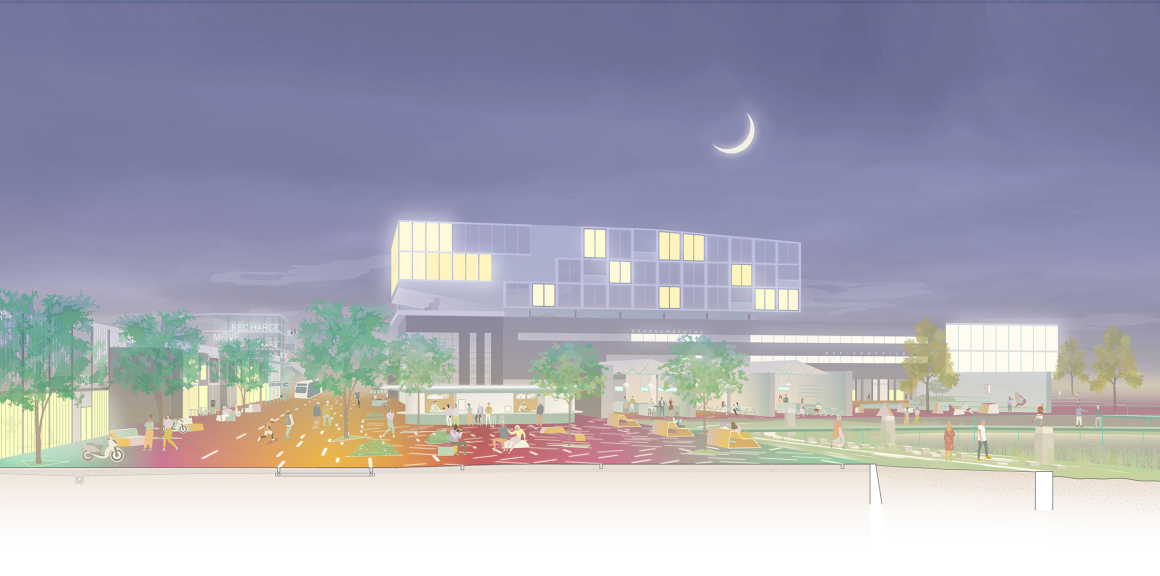
地点: 荷兰
客户: van Rijksadviseurs学院-Mike Emmerik,Daan Zandbelt
年份: 2019-2020
类型: 设计研究
团队和合作者: Michiel van Driessche,Marnix Vink,Deborah Lambert,Eduardo Marin,Salinas, Elan Redekop van der Meulen,Cherk Ga Leung,Sander van der Ham: Stipo
图片: ©Felixx
办公室: Felixx Landscape architects & planners
公司官网: www.felixx.nl
联系邮箱: felixx@felixx.nl
Location: The Netherlands
Client: College van Rijksadviseurs – Mike Emmerik, Daan Zandbelt
Year: 2019 – 2020
Type: Research by design
Team and Partners: Michiel van Driessche,Marnix Vink,Deborah Lambert,Eduardo Marin,Salinas, Elan Redekop van der Meulen,Cherk Ga Leung,Sander van der Ham: Stipo
Copyrights: ©Felixx
Offices: Felixx Landscape architects & planners
Web: www.felixx.nl
Contact email: felixx@felixx.nl




不一样的表达方式